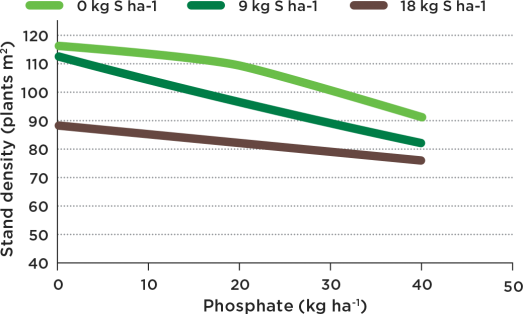Aim for improved nutrient use efficiency
Fertility management is one of the five pillars in the Canadian canola industry’s goal to increase average yields to 52 bu./ac. by 2025. This yield will allow Canada’s canola industry to keep pace with global increases in oil and meal demand while keeping a cap on canola acres.
Canola Council of Canada agronomy goals for the fertility management pillar are to target fertilizer applications to be available when the plant requires it and in a form that reduces loss to the air and water. Use of precision agriculture and data management, and increased use of fertilizer stability products will help. Increased adoption of 4R Nutrient Management guidelines will also result in improved soil and water health.
There is no ‘one size fits all’ approach to achieve sustainable production, but here are a few practices to consider:
If applying fall fertilizer, use banding to minimize run-off.
Fall applications of nitrogen can be a logistical benefit, reducing the amount of fertilizer handled at the time of seeding. Research on the Prairies has shown that fall-banded fertilizer is just as efficient as spring broadcast, but fall broadcast is only 80 per cent as efficient as those two other choices. The best choice for fertilizer efficiency is spring banding. Fall banding using a disc opener to reduce soil disturbance and a fertilizer efficiency aid (such as urease inhibitors, nitrogen inhibitors or controlled-release nitrogen) can further improve the efficiency. When applying, band urea at least two inches deep and NH3 deep enough that you can’t smell it releasing from the soil. (For more on the science, read “Improve nitrogen use efficiency” – Canola Digest Science Edition 2014.)
Keep seed-applied fertilizer to a minimum. Because a strong, uniform canola stand is so important to yield potential and pest management, growers will want to limit seed-placed fertilizer. Canola seed and seedlings are especially sensitive to nitrogen fertilizer. Safety of seed-placed nitrogen can be improved with higher seed-bed utilization (narrower rows and wider openers), certain soil characteristics (more clay and lower pH improves safety), polymer coatings and moisture, but the general recommendation is to apply up to 20 lb./ac. of phosphate with the seed and place everything else outside the seed row. A study led by Cindy Grant, now-retired research scientist with Agriculture and Agri-Food Canada (AAFC) in Brandon, compared canola stand density with various rates of seed-placed phosphate and sulphate fertilizer. The study found that adding any amount of sulphate with the phosphate reduced stand density. While canola does often benefit from sulphur fertilizer, it is better applied outside the seed row. (See Figure 1. For a summary of the study, read “Product and placement” – Canola Digest Science Edition 2013.)
Figure 1. Seed-placed sulphate and phosphate fertilizers can reduce canola and stand density

Apply rates that align with increased yield potential. Two canola studies from the past decade showed that canola yield will keep going up with higher rates of nitrogen. The message is that farmers could use higher nitrogen rates to coax more yield out of the crop, but the right economic rate will be lower than the ‘top yield’ rate. Sustainable nutrient investment finds the balance between potential yield and economic risk tolerance. (This discussion, including background on the two studies, is covered the article “Apply enough nitrogen” – Canola Digest Science Edition 2014.)
Use soil tests to determine what each field needs. Soil tests are helpful to show soil nutrient reserves and to see how fertilizer rates could be adjusted field to field and over time. Farmers looking for more precision may set fertilizer rates based on field management zones. This will require more refined analysis but could reduce losses, put a stop to unproductive applications and increase profit. (For more on these concepts, read “Annual soil tests improve nitrogen returns” – Canola Digest Science Edition 2015 and “Soil sampling in the big data era” – Canola Digest, January 2018.) Another precision approach is overlap-limiting technology, available on newer drills, to shut off fertilizer application on areas the drill has already passed over. This will have an economic benefit because the double-applied nutrient is not used and can actually hurt yield by increasing lodging. Overlap prevention also has an environmental benefit because these doubled rates could result in increased nutrient losses.





